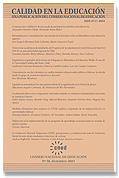Physical Education as a Curricular Component Assessed in National Standardized Exams in America and Europe
DOI:
https://doi.org/10.31619/caledu.n59.1318Keywords:
Standardized Exams, High School, Physical Education, America, EuropeAbstract
The prevalence of large-scale examinations in educational systems worldwide, from primary to higher education, has prompted increased attention in the academic discourse assessments. This article addresses the imperative to delve deeper into discussions surrounding these evaluations, focusing on national standardized exams designed for secondary education students in American and European countries. Employing a qualitative approach, this study takes the form of documentary and exploratory research, analyzing official documents of 10 exams applied in 21 countries. The results reveal three key aspects: a) the establishment of exam culture for over two centuries, originating in European countries; b) the progressive inclusion of Physical Education as an evaluated curricular component, though belatedly; c) similarities in the understanding of the subject area and the evaluated contents, with a predominant emphasis on sports. The study concludes that the majority of these exams aim to provide professional qualification and certification for further education. Moreover, there are initiatives aimed at elevating the significance of curricular components such as Physical Education in national evaluation policies. This raises questions regarding the underlying intentions of these exams in specific contexts, particularly within the diverse group of countries across the American and European continents.
Downloads
Published
Issue
Section
License
Copyright (c) 2023 Calidad en la Educación

This work is licensed under a Creative Commons Attribution 4.0 International License.
Authors retain their Copyright and only transfer a part of these to the journal, accepting the following conditions:
Authors keep their rights as authors and guarantee the right to the journal for the first publication of their work, which is simultaneously subject to the Creative Commons Attribution license allowing third parties to share the study accrediting the author and first publication in this journal.
Authors may adopt other non-exclusive license agreements for distribution of the version of the published work (e.g. inclusion in an institutional thematic file or publication in a monographic volume) accrediting initial publication in this journal.
Authors are allowed and recommended to share their work over the Internet (e.g. in institutional telematic files or their website) before and during the submission process, which may lead to interesting exchanges and increased citation of the published work. (See The effect of open access).

